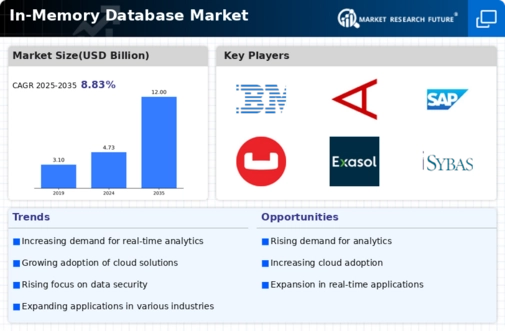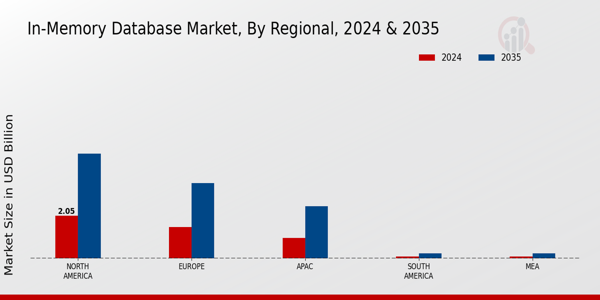Market Growth Projections
Emergence of Big Data Technologies
The Global In-Memory Database Market Industry is significantly influenced by the emergence of big data technologies, which necessitate advanced data management solutions. As organizations collect vast amounts of data from diverse sources, the ability to process and analyze this information efficiently becomes paramount. In-memory databases provide the necessary infrastructure to handle big data workloads, allowing for faster analytics and reporting. Industries such as healthcare and manufacturing leverage these databases to derive insights from large datasets, enhancing operational efficiency. The growing integration of big data technologies with in-memory databases is likely to drive market expansion, aligning with the projected growth trajectory of the industry.
Increased Adoption of Cloud Computing
The Global In-Memory Database Market Industry is witnessing a surge in the adoption of cloud computing technologies, which facilitate the deployment of in-memory databases. Cloud platforms offer scalability, flexibility, and cost-effectiveness, making them attractive for organizations looking to optimize their data management strategies. As businesses migrate to cloud environments, the integration of in-memory databases becomes essential for achieving high performance and low latency. This trend is expected to contribute to the market's growth, with projections indicating a market value of 12 USD Billion by 2035. The synergy between cloud computing and in-memory databases is likely to reshape data management practices globally.
Need for Improved Customer Experience
The Global In-Memory Database Market Industry is increasingly shaped by the need for improved customer experience. Businesses recognize that delivering personalized and timely services is essential for retaining customers in a competitive landscape. In-memory databases enable organizations to analyze customer data in real-time, facilitating tailored interactions and enhancing overall satisfaction. For example, retailers utilize these databases to track customer preferences and buying patterns, allowing for targeted promotions and recommendations. As companies prioritize customer-centric strategies, the demand for in-memory databases is expected to rise, contributing to the market's growth and aligning with the broader trend of enhancing customer engagement.
Growing Demand for Real-Time Analytics
The Global In-Memory Database Market Industry experiences a robust demand for real-time analytics, driven by the need for immediate data processing and insights. Organizations across various sectors, including finance and retail, increasingly rely on in-memory databases to enhance decision-making processes. For instance, companies utilize these databases to analyze customer behavior in real-time, enabling personalized marketing strategies. This trend is reflected in the projected market value of 4.73 USD Billion in 2024, indicating a significant shift towards data-driven operations. As businesses seek to gain a competitive edge, the adoption of in-memory databases for real-time analytics is likely to accelerate.
Rising Need for Enhanced Data Processing Speed
The Global In-Memory Database Market Industry is propelled by the rising need for enhanced data processing speed. Traditional databases often struggle to keep pace with the increasing volume and velocity of data generated by modern applications. In-memory databases, by storing data in RAM rather than on disk, significantly reduce latency and improve transaction speeds. This capability is particularly crucial for industries such as telecommunications and e-commerce, where milliseconds can impact customer satisfaction and revenue. The anticipated compound annual growth rate of 8.83% from 2025 to 2035 underscores the urgency for businesses to adopt faster data processing solutions, positioning in-memory databases as a vital component of their infrastructure.
























